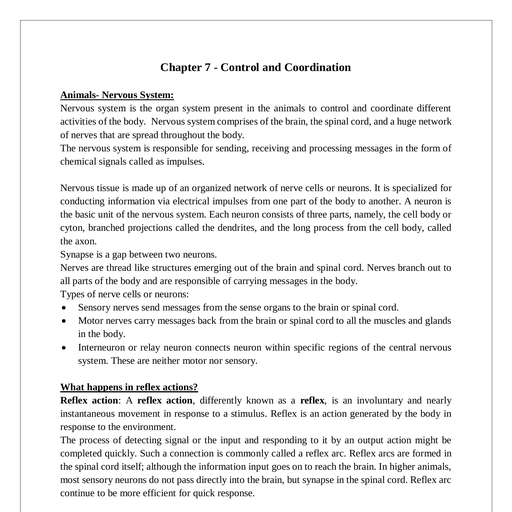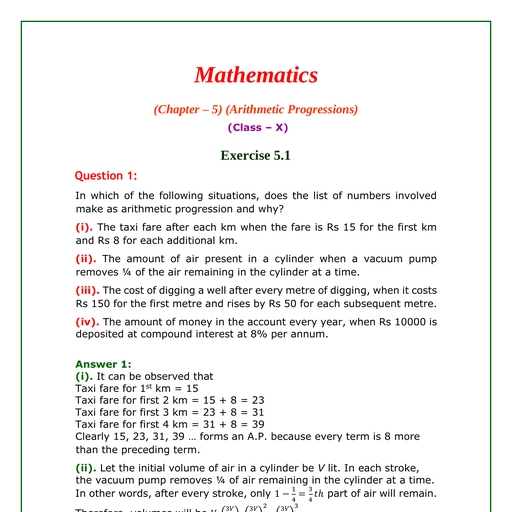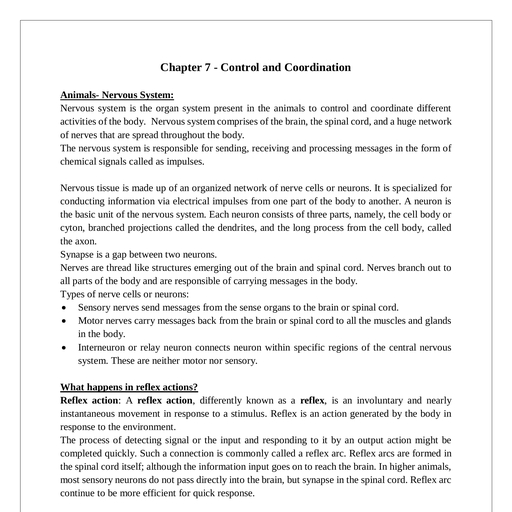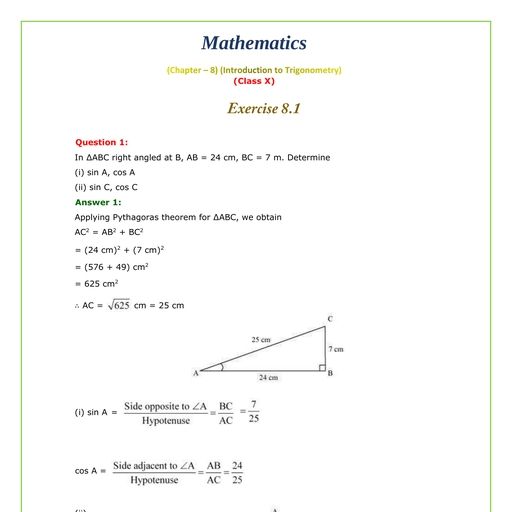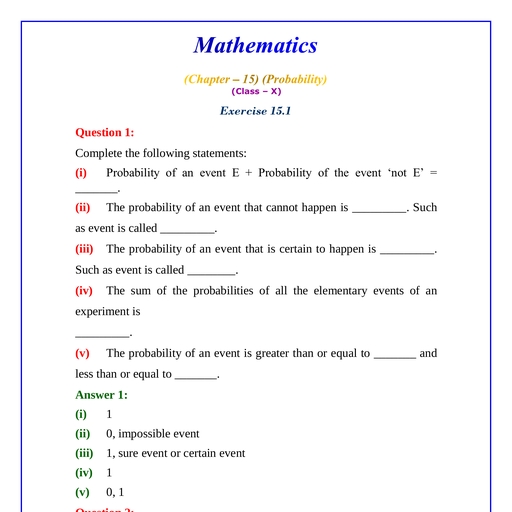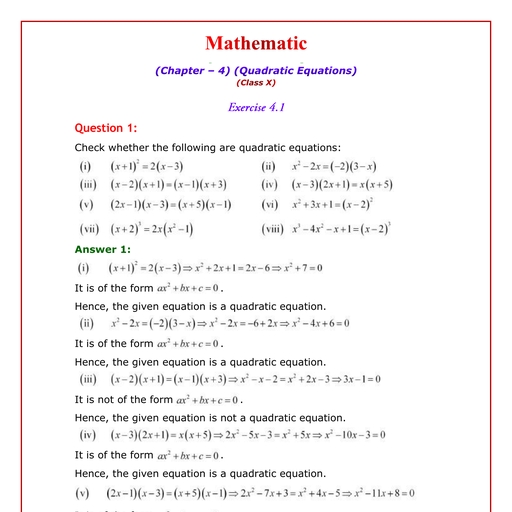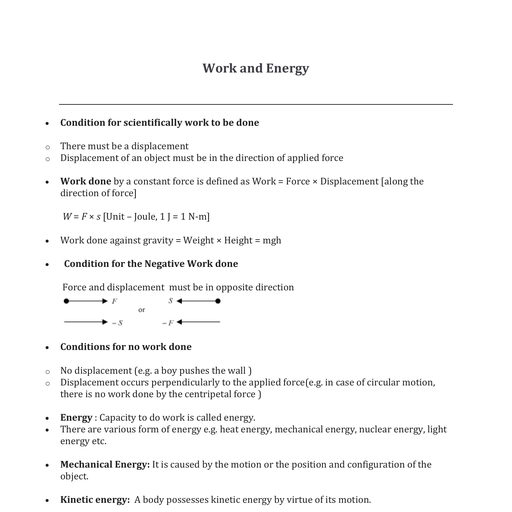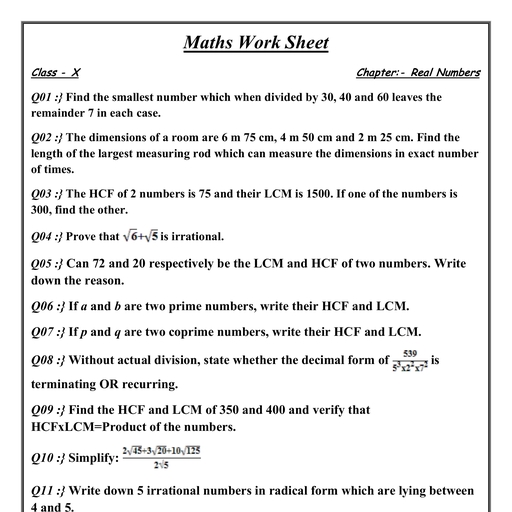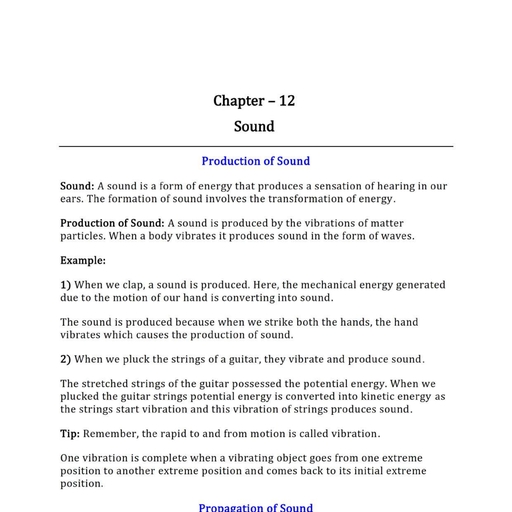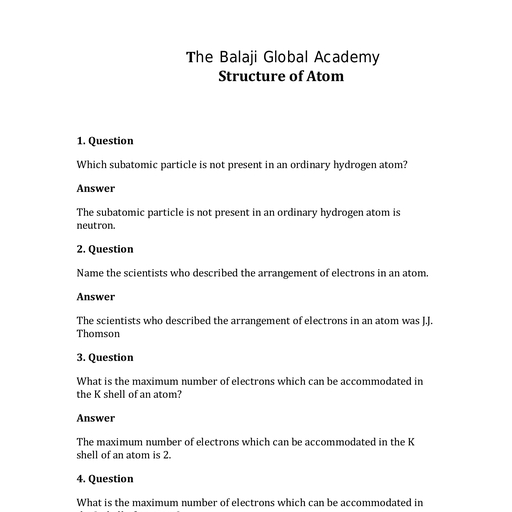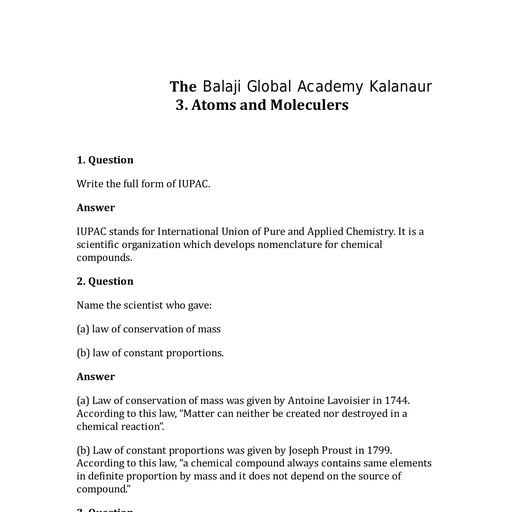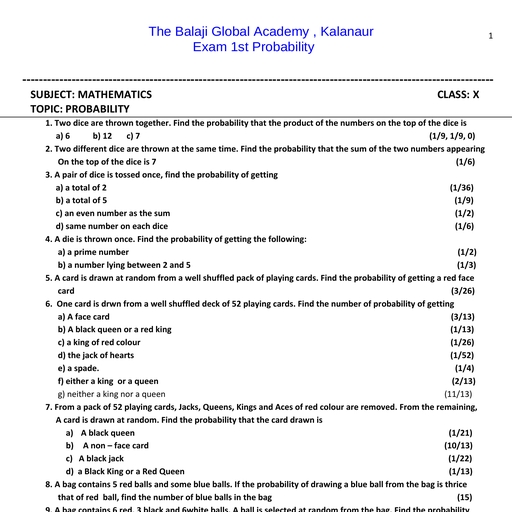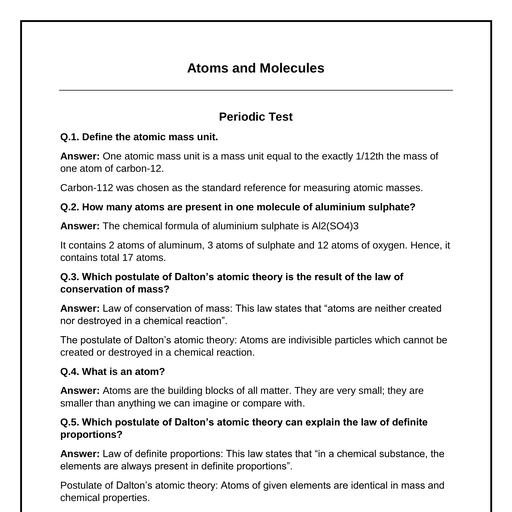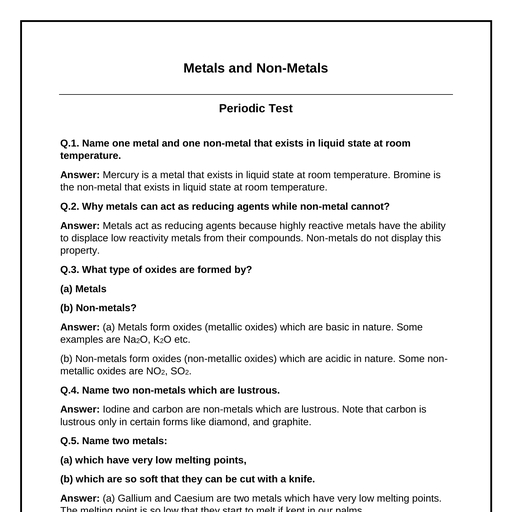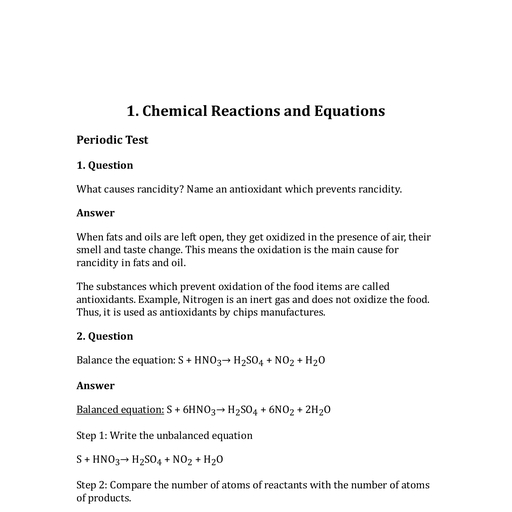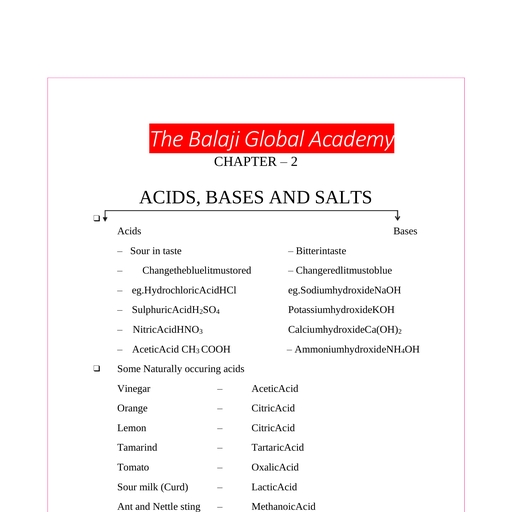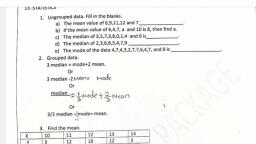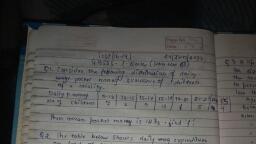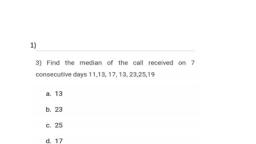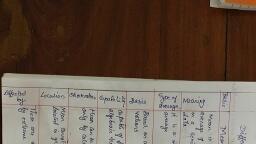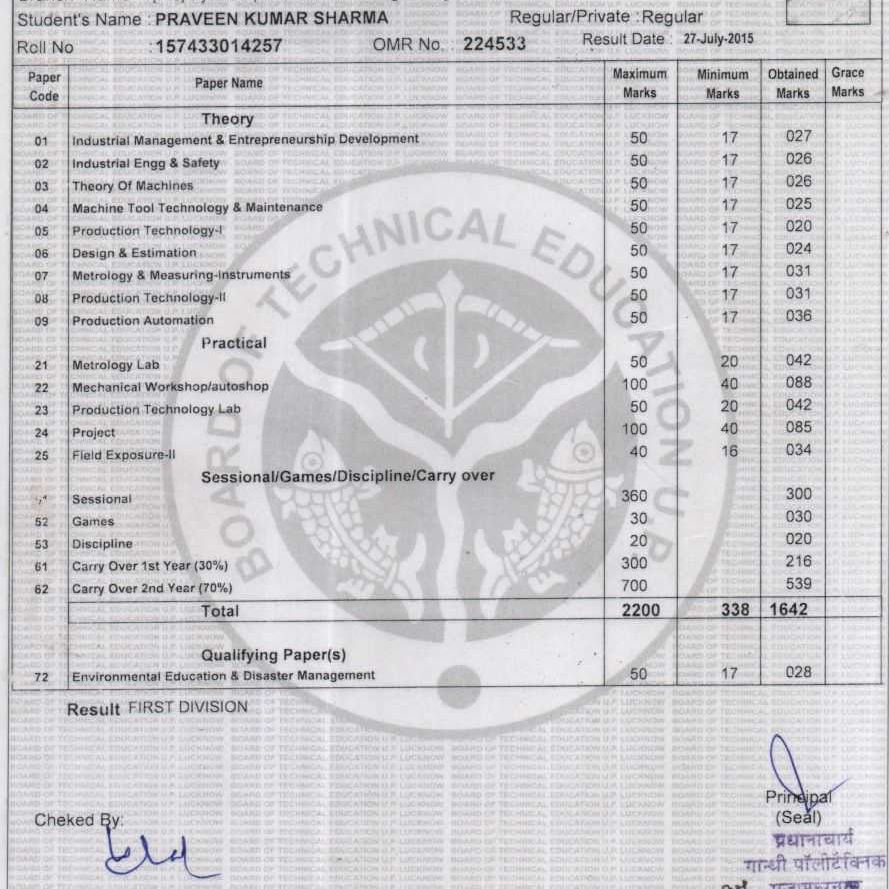Question 1 :
Find the approximate value of mode for the following data $:$<br><table class="wysiwyg-table"><tbody><tr><td>Class interval<br></td><td>$7-14$<br></td><td>$14-21$<br></td><td>$21-28$<br></td><td>$28-35$<br></td><td>$35-42$<br></td></tr><tr><td>Frequency<br></td><td>$2$<br></td><td>$4$<br></td><td>$3$<br></td><td>$10$<br></td><td>$1$<br></td></tr></tbody></table><br>
Question 2 :
Find the mode of $14$, $25$, $14$, $28$, $18$, $17$, $18$, $14$, $23$, $22$, $14$, $18$.<br/>
Question 4 :
The median of a given frequency distribution is found graphically with the help of __________.
Question 6 :
<div><span>The marks of $20$ students in a test were as follows:</span><br/><span>$5, 6, 8, 9, 10, 11, 11, 12, 13, 13, 14, 14, 15, 15, 15, 16, 16, 18, 19, 20$</span><br/></div>The mode is
Question 7 :
Median of a given frequency distrlbution is found with the help of a<br>
Question 9 :
<table class="table table-bordered"><tbody><tr><td> Marks</td><td> 10-20</td><td> 20-30</td><td> 30-40</td><td> 40-50</td><td> 50-60</td></tr><tr><td> Frequency</td><td> 4</td><td> 10</td><td> 20</td><td> 40</td><td> 50</td></tr></tbody></table>The following frequency distribution shows the marks obtained by $124$ students in Economy at a certain school. Find the arithmetic mean using the direct method.
Question 10 :
The wickets taken by a bowler in a one-day cricket match are $4, 5, 6, 3, 4, 0, 3, 2, 3, 5.$ The mode of the data is ...............
Question 13 :
Choose the formula used for arithmetic mean of grouped data by Assumed mean method is
Question 14 :
While computing mean of grouped data, we assume that the frequencies are:
Question 15 :
<table class="table table-bordered"><tbody><tr><td> Number of employees</td><td>2 </td><td> 5</td><td> 6</td><td> 7</td><td> 8</td></tr><tr><td> Daily wedges</td><td> 500</td><td> 750</td><td>200 </td><td> 400</td><td> 600</td></tr></tbody></table>Estimate the mean of the following data 
Question 16 :
A cricket player scored the following runs in $11$ one-day international matches:<br/>$65$, $30$, $7$, $60$, $65$, $65$, $30$, $28$, $30$, $15$, $30$ Find the modal runs. <br/>
Question 17 :
The modal value is the value of the variate which divides the total frequency into two equal parts.
Question 18 :
The mean of 20 items of a data is 5 and if each item is multiplied by 3 then the mean will be
Question 19 :
Find the mean of the data given below, if following are the marks obtained by students in a class test in the mathematics subject.<br><table class="wysiwyg-table"><tbody><tr><td>Marks:</td><td>10</td><td>20</td><td>30</td><td>40</td><td>50</td><td>60</td></tr><tr><td>Number of student</td><td>5</td><td>12</td><td>32</td><td>40</td><td>45</td><td>48</td></tr></tbody></table>
Question 20 :
The mode is the number that is repeated more _____ than any other.<br>
Question 22 :
Consider the data: $2, 3, 2, 4, 5, 6, 4, 2, 3, 3, 7, 8, 2, 2$. The frequency of $2$ is _____
Question 24 :
Find the mean of the following data, by using the assumed mean method.<br/><table class="wysiwyg-table"><tbody><tr><td>Class Interval<br/></td><td>$0-10$<br/></td><td>$10-20$<br/></td><td>$20-30$<br/></td><td>$30-40$<br/></td><td>$40-50$<br/></td></tr><tr><td>Frequency<br/></td><td>$7$<br/></td><td>$8$<br/></td><td>$12$<br/></td><td>$13$<br/></td><td>$10$<br/></td></tr></tbody></table>
Question 27 :
The _____ is the value that appears most often in a set of data.<br>
Question 28 :
The average of daily wages for the workers of the two factories combined is <table class="wysiwyg-table"><tbody><tr><td>No.of wage earners</td><td>Factory A 250</td><td>Factory B 200</td></tr><tr><td>Average daily wage </td><td>Rs.2.00</td><td>Rs.2.50</td></tr></tbody></table>
Question 30 :
State true or false:<div>The mode is the most frequently occurring observation.<br/></div>
Question 31 :
Calculate the mode for $17, 12, 19, 11, 20, 11, 20, 19, 10, 25,19$.
Question 34 :
<table class="wysiwyg-table"><tbody><tr><td>Class </td><td>0-20</td><td>20-40</td><td>40-60</td><td>60-80</td><td>80-100</td><td><br></td></tr><tr><td>Frequency</td><td>19</td><td>$f_1$</td><td>32</td><td>$f_2$</td><td>19</td><td>Total 120</td></tr></tbody></table>Mean of the above frequency table is given as $50$. Find $f_1$ and $f_2$.
Question 35 :
Mode of $2, 3, 4, 5, 0, 1, 3, 3, 4, 3\ is\ 3.$
Question 36 :
Mode of the distribution is that value of the variate for which the_____is_____
Question 37 :
For a given data with 50 observations the 'less than ogive' and the 'more than ogive' intersect at (15.5, 20) The median of the data is
Question 39 :
Frequency distribution of daily commission received by 100 salesmen is given.<br/><table class="wysiwyg-table"><tbody><tr><td>Daily commission (in Rs.)</td><td>$100 - 120$</td><td>$120 - 140$</td><td>$140 - 160$</td><td>$160 - 180$</td><td>$180 - 200$</td></tr><tr><td>No. of salesman</td><td>$20$</td><td>$45$</td><td>$22$</td><td>$9$</td><td>$4$</td></tr></tbody></table>Find mean daily commission received by a salesman.<br/>
Question 43 :
For a given data with $50$ observation the less than ogive and the more than ogive intersect at $(15.5, 20)$, the median of the data is <br/><br/>
Question 44 :
The median of a given frequency distribution is found graphically with the help of
Question 45 :
Which measure of central tendancy is given by the x co-ordinate of the point of intersection of the more than Ogive and less than Ogive 
Question 46 :
The X coordinate of the point of intersection of both the type of ogive " more than" and "less than" gives the value of the:
Question 48 :
The measure of central tendency which is given by the x-coordinate of the point of intersection of the 'more than' ogive and 'less than' ogive is<br/>
Question 49 :
<span>Read the following news report and answer on the basis of the same: For an examination, 60 students of a school appeared. Marks obtained by the 12 students were 25 each. The number of students who scored 20 and 5 each was three more than the students who scored 25. Also, 8 students who scored 10 marks each. The students who scored 15 marks each were half the students who scored 10 each and remaining students had scored 30 each. Answer the following question:</span><br/><span>The series so obtained from the given paragraph is:</span>
Question 50 :
<p><span>A survey was conducted to identify vegetarians in a group of people. Find the mode of the data.</span></p><table class="wysiwyg-table"><tbody><tr><td>Group</td><td>$5-7$</td><td>$7-9$</td><td>$9-11$</td><td>$11-13$</td><td>$13-15$</td><td>$15-17$</td></tr><tr><td>Frequency</td><td>$6$</td><td>$7$</td><td>$3$</td><td>$7$</td><td>$12$</td><td>$9$</td></tr></tbody></table>
Question 52 :
If $u_i \displaystyle = \frac{x_i - 25}{10} , \sum f_i u_i=20$ and $\sum f_i =100$, then $\overline {x}$ is equal to <br>
Question 53 :
The choices of the fruits of 42 students in a class are as follows:<br>A, O, B, M, A, G, B, G, A, G, B, M. A, O, M, A, B, G, M, B, A, O, M, O, G, B, O, M, G, A, A, B, M, O, M, G, B, A, M, O, M, O, where A, B, G, M and O stands for Apple, Banana, Grapes, Mango and Orange <span>respectively.<br>Which two fruits are liked by an equal number of students?</span>
Question 54 :
In the frequency distribution of discrete data given below the frequency $y$ against value $0$ is missing <table class="wysiwyg-table"><tbody><tr><td>Variable $(x)$</td><td>$0$</td><td>$1$</td><td>$2$</td><td>$3$</td><td>$4$</td><td>$5$</td></tr><tr><td>Frequency $(f)$</td><td>$y$</td><td>$20$</td><td>$40$</td><td>$40$</td><td>$20$</td><td>$4$</td></tr></tbody></table>If the mean is $2.5$ then the missing frequency $y$ will be __________
Question 55 :
For a given data with 35 observations the less than ogive' and more than ogive' intersect at<br/>(28.5, 30). The median of the data is :<br/>
Question 56 :
The ages of the $115$ people who live on an apartment are grouped as follows$:$  <span>The mean length of the plants is $33.43$years using direct method. Find y in the table.</span><br/><table class="wysiwyg-table"><tbody><tr><td>Age(years)</td><td>Number of people</td></tr><tr><td>$0-10$</td><td>$10$</td></tr><tr><td>$10-20$</td><td>$15$</td></tr><tr><td>$20-30$</td><td>$26$</td></tr><tr><td>$30-40$</td><td>Y</td></tr><tr><td>$40-50$</td><td>$23$</td></tr><tr><td>$50-60$</td><td>$16$</td></tr><tr><td>$60-70$</td><td>$3$</td></tr><tr><td>$70-80$</td><td>$1$</td></tr></tbody></table>
Question 57 :
The given distribution shows the number of runs scored by some top batsmen of the world in one day international cricket matches:<br><table class="wysiwyg-table"><tbody><tr><td>Runs scored<br></td><td>No. of batsman<br></td></tr><tr><td>3000-4000<br></td><td>4<br></td></tr><tr><td>4000-5000<br></td><td>18<br></td></tr><tr><td>5000-6000<br></td><td>9<br></td></tr><tr><td>6000-7000<br></td><td>7<br></td></tr><tr><td>7000-8000<br></td><td>6<br></td></tr><tr><td>8000-9000<br></td><td>3<br></td></tr><tr><td>9000-10000<br></td><td>1<br></td></tr><tr><td>10000-11000<br></td><td>1<br></td></tr></tbody></table>Find the mode of the data<br>
Question 58 :
Consider the following distribution of daily wages of 50 workers of a factory.<br><table class="wysiwyg-table"><tbody><tr><td>Daily wages (in Rs.)<br></td><td>Number of workers<br></td></tr><tr><td>100-120<br></td><td>12<br></td></tr><tr><td>120-140<br></td><td>14<br></td></tr><tr><td>140-160<br></td><td>8<br></td></tr><tr><td>160-180<br></td><td>6<br></td></tr><tr><td>180-200<br></td><td>10<br></td></tr></tbody></table>Find the mean daily wages of the workers of the factory by using an appropriate method.<br>
Question 59 :
Find the arithmetic mean for the given data:<div><br/><table class="wysiwyg-table"><tbody><tr><td>Marks</td><td>No. of students</td></tr><tr><td>$0-10$</td><td>$5$</td></tr><tr><td>$10-20$</td><td>$10$</td></tr><tr><td>$20-30$</td><td>$25$</td></tr><tr><td>$30-40$</td><td>$30$</td></tr><tr><td>$40-50$</td><td>$20$</td></tr><tr><td>$50-60$</td><td>$10$</td></tr></tbody></table><br/></div>
Question 60 :
<span>The percentage of marks obtained by the students in a class of $50$ are given below. Find the mean for the following data.<br/></span><table class="wysiwyg-table"><tbody><tr><td>Marks$(\%)$</td><td>$40-50$</td><td>$50-60$</td><td>$60-70$</td><td>$70-80$</td><td>$80-90$</td><td>$90-100$</td></tr><tr><td>Number of students</td><td>$6$</td><td>$12$</td><td>$14$</td><td>$8$</td><td>$6$</td><td>$4$</td></tr></tbody></table>
Question 61 :
For the next three (03) items that follow : <br/>The number of telephone calls received in 245 successive one minute intervals at an exchange is given below in the following frequency distribution. <br/><table class="wysiwyg-table"><tbody><tr><td>Number of calls</td><td>0</td><td>1</td><td>2</td><td>3</td><td>4</td><td>5</td><td>6</td><td>7</td></tr><tr><td>Frequency</td><td>14</td><td>21</td><td>25</td><td>43</td><td>51</td><td>40</td><td>39</td><td>12</td></tr></tbody></table>  What is the mean of the distribution?<br/>
Question 62 :
Frequency distribution of distance travelled in kms. per liter of petrol by different mopeds is given below.<br/><table class="wysiwyg-table"><tbody><tr><td>Distance travelled (in km/lit)</td><td>62 - 65</td><td>65 - 68</td><td>68 - 71</td><td>71 - 74</td><td>74 - 77</td><td>77 - 80</td><td>80 - 83</td></tr><tr><td>No.of mopeds</td><td>5</td><td>8</td><td>12</td><td>28</td><td>35</td><td>10</td><td>2</td></tr></tbody></table>Find mean distance travelled per liter of petrol by a moped.
Question 64 :
<table class="wysiwyg-table"><tbody><tr><td>Class</td><td>0-10</td><td>10-20</td><td>20-30</td><td>30-40  </td><td>40-50</td></tr><tr><td>Frequency</td><td>5</td><td>$x$</td><td>15</td><td>16</td><td>6</td></tr></tbody></table>The missing frequency marked $\displaystyle x$ of the above distribution whose mean is 27 is : 
Question 65 :
The mode for the following frequency distribution is:<br/><br/><table class="wysiwyg-table"> <tbody><tr> <td>Size of<br/>items</td> <td>Frequency</td> <td>Size of items</td> <td>Frequency</td> </tr> <tr> <td>0-4</td> <td>5</td> <td>20-24</td> <td class="wysiwyg-text-align-right">10</td> </tr> <tr> <td>4-8</td> <td>7</td> <td>24-28</td> <td class="wysiwyg-text-align-right">6</td> </tr> <tr> <td>8-12</td> <td>9</td> <td>28-32</td> <td class="wysiwyg-text-align-right">3</td> </tr> <tr> <td>12-16</td> <td>17</td> <td>32-36</td> <td class="wysiwyg-text-align-right">1</td> </tr> <tr> <td>16-20</td> <td>12</td> <td>36-40</td> <td class="wysiwyg-text-align-right">0</td> </tr></tbody></table><br/><br/>
Question 66 :
Mean of $50$ observations was found to be $80.4$. But later on, it was discovered that $96$ was misread as$ 69$ at one place. Find the correct mean.<br>
Question 67 :
The following data gives the information on the observed lifetimes (in hours) of $225$ electrical components:<br/><table class="wysiwyg-table"><tbody><tr><td>Lifetimes (in hours)<br/></td><td>0-20<br/></td><td>20-40<br/></td><td>40-60<br/></td><td>60-80<br/></td><td>80-100<br/></td><td>100-120<br/></td></tr><tr><td>Frequency<br/></td><td>10<br/></td><td>35<br/></td><td>52<br/></td><td>61<br/></td><td>38<br/></td><td>29</td></tr></tbody></table>Determine the modal lifetimes of the components.<br/>
Question 68 :
<table class="wysiwyg-table"><tbody><tr><td></td><td>Factory A</td><td>Factory B</td></tr><tr><td>No. of wage earners</td><td>250</td><td>200</td></tr><tr><td>Average daily wage</td><td>Rs. 2.00</td><td>Rs. 2.50</td></tr></tbody></table>The average of daily wages for the earners of the two factories combined is
Question 69 :
Frequency distribution of duration of $500$ telephone calls received at a telephone exchange on a certain day is given below :<br/><table class="wysiwyg-table"><tbody><tr><td>Duration of call (in sec.)</td><td>15 - 29</td><td>30 - 44</td><td>45 - 59</td><td>60 - 74</td><td>75 - 89</td><td>90 - 104</td><td>105 - 119</td><td>120 - 134</td></tr><tr><td>No. of calls</td><td>8</td><td>12</td><td>61</td><td>153</td><td>190</td><td>57</td><td>10</td><td>9</td></tr></tbody></table>Find mean duration of telephone call received at the telephone exchange.
Question 70 :
<span>Find the mode of:</span><div>$7, 7, 8, 10, 10, 11, 10, 13, 14$<br/></div>
Question 71 :
The mode of the following data is $85.7$. Find the missing frequency in it.<br/><table class="wysiwyg-table"><tbody><tr><td>Size<br/></td><td>Frequency<br/></td></tr><tr><td>45-55<br/></td><td>7<br/></td></tr><tr><td>55-65<br/></td><td>12<br/></td></tr><tr><td>65-75<br/></td><td>17<br/></td></tr><tr><td>75-85<br/></td><td>f<br/></td></tr><tr><td>85-95<br/></td><td>32<br/></td></tr><tr><td>95-105<br/></td><td>6<br/></td></tr><tr><td>105-115<br/></td><td>10<br/></td></tr></tbody></table>
Question 72 :
Which of the following item to be represented on X-axis in drawing less than ogive ?
Question 74 :
<span>Calculate mode for the following data shows the number of colour pencils the students have in a class.<br/></span><table class="wysiwyg-table"><tbody><tr><td>Colour Pencils</td><td>$0-5$</td><td>$5-10$</td><td>$10-15$</td><td>$15-20$</td><td>$20-25$</td><td>$25-30$</td></tr><tr><td>Number of students</td><td>$14$</td><td>$16$</td><td>$17$</td><td>$13$</td><td>$8$</td><td>$12$</td></tr></tbody></table>
Question 75 :
Find the mean of the following frequency distribution:<br/><table class="wysiwyg-table"><tbody><tr><td>Age (in years)<br/></td><td>$18$<br/></td><td>$19$<br/></td><td>$20$<br/></td><td>$21$<br/></td><td>$22$<br/></td></tr><tr><td>No. of boys<br/></td><td>$14$<br/></td><td>$10$<br/></td><td>$20$<br/></td><td>$24$<br/></td><td>$12$<br/></td></tr></tbody></table><br/>
Question 76 :
The frequency distribution of marks in English are given in the table:<br><table class="wysiwyg-table"><tbody><tr><td>Marks<br></td><td>50-60<br></td><td>60-70<br></td><td>70-80<br></td><td>80-90<br></td></tr><tr><td>Number of students<br></td><td>12<br></td><td>24<br></td><td>14<br></td><td>10<br></td></tr></tbody></table>Find the mean by step deviation method.<br>
Question 77 :
Find the missing value of P for the following distribution whose mean is $12.58$<br/><table class="wysiwyg-table"><tbody><tr><td>$x_i$</td><td>5</td><td>8</td><td>10</td><td>12</td><td>P</td><td>20</td><td>25</td></tr><tr><td>$f_i$<br/></td><td>2</td><td>5</td><td>8</td><td>22</td><td>7</td><td>4</td><td>2</td></tr></tbody></table>
Question 80 :
Find the mode for the following data$:$<br><table class="wysiwyg-table"><tbody><tr><td>Farm size</td><td>$12$</td><td>$13$</td><td>$14$</td><td>$15$</td><td>$17$</td><td>$18$</td><td>$19$</td><td>$20$</td></tr><tr><td>Number of animals</td><td>$3$</td><td>$4$</td><td>$4$</td><td>$2$</td><td>$1$</td><td>$2$</td><td>$4$</td><td>$1$</td></tr></tbody></table>
Question 81 :
<div><table class="table table-bordered"><tbody><tr><td> Marks</td><td>0-10 </td><td>10-20 </td><td>20-30 </td><td>30-40 </td><td>40-50 </td><td>50-60 </td><td>60-70 </td><td>70- 80</td><td>80-90 </td><td>90-100 </td></tr><tr><td> Frequency</td><td>3 </td><td>5 </td><td>6 </td><td>7 </td><td>8 </td><td> 9</td><td> 10</td><td> 12</td><td> 6</td><td>4 </td></tr></tbody></table></div><div><br/></div>Find the mean mark using step deviation method:<br/>
Question 83 :
In a study on a certain population, the following data was given. <br><table class="wysiwyg-table"><tbody><tr><td>Population (X)<br></td><td>2000-2001<br></td><td>2001-2002<br></td><td>2002-2003<br></td><td>2003-2004<br></td><td>2004-2005<br></td><td>2005-2006<br></td><td>2006-2007<br></td></tr><tr><td>Number of people<br></td><td>10<br></td><td>20<br></td><td>30<br></td><td>40<br></td><td>50<br></td><td>60<br></td><td>70<br></td></tr></tbody></table><br>Find the average number of population using step deviation method.<br>
Question 85 :
If the mean of following frequency distribution is $188$ find the missing frequencies $\displaystyle f_{1}\: and\: f_{2}$<br/><table class="wysiwyg-table"><tbody><tr><td>C.I.</td><td>0-80</td><td>80-160</td><td>160-240</td><td>240-320</td><td>320-400</td><td>Total</td></tr><tr><td>Freq.</td><td>20</td><td>25</td><td>$\displaystyle f_{1}$</td><td>$\displaystyle f_{2}$</td><td>10</td><td>100</td></tr></tbody></table>
Question 86 :
Below is given frequency distribution of dividend in percentage declared by 120 companies.<br><table class="wysiwyg-table"><tbody><tr><td>Dividend (in %)</td><td>10 - 19</td><td>20 - 29</td><td>30 - 39</td><td>40 - 49</td><td>50 - 59</td><td> 60 - <br>69</td><td>70 - 79 </td></tr><tr><td>No. of Companies</td><td>5</td><td>15</td><td>28</td><td>42</td><td>15</td><td>12</td><td>3</td></tr></tbody></table>Obtain mean dividend declared by a company by step deviation method.
Question 87 :
<span>What is the mode of $19, 19, 15, 20, 25, 15, 20, 15$?</span>
Question 88 :
Following table gives frequency distribution of trees planted by different housing societies in a particular locality.<br>Find mean number of trees planted by housing society by using 'step deviation method'.<br><table class="wysiwyg-table"><tbody><tr><td>No. of tress</td><td>10 - 15</td><td>15 - 20</td><td>20 - 25</td><td>25 - 30</td><td>30 - 35</td><td>35 - 40</td></tr><tr><td>No. of Societies</td><td>2</td><td>7</td><td>9</td><td>8</td><td>6</td><td>4</td></tr></tbody></table>
Question 89 :
<span>In a school the mark distribution of $25$ students in a mathematics examination is given below. Calculate it's mode.<br/></span><table class="wysiwyg-table"><tbody><tr><td>Marks</td><td>$30-40$</td><td>$40-50$</td><td>$50-60$</td><td>$60-70$</td><td>$70-80$</td><td>$80-90$</td></tr><tr><td>No. of students</td><td>$3$</td><td>$2$</td><td>$4$</td><td>$10$</td><td>$4$</td><td>$2$</td></tr></tbody></table>
Question 90 :
<span>Find the arithmetic mean for the following grouped frequency distribution:</span><br/><table class="wysiwyg-table"><tbody><tr><td>Class-intervals<br/></td><td>$6-10$<br/></td><td>$10-14$<br/></td><td>$14-18$<br/></td><td>$18-22$<br/></td><td> $22-26$<br/></td><td> $26-30$<br/></td></tr><tr><td>Frequency<br/></td><td> $ 4$<br/></td><td>  $ 6$<br/></td><td>  $9$<br/></td><td>  $ 12$<br/></td><td>   $ 7 $<br/></td><td>   $2$<br/></td></tr></tbody></table><br/>
Question 94 :
If the mode of five observations, in order, $0, 2, 3, m, 5$ is $3$ then $m =$ _______.
Question 96 :
The mode of the following series is 36. Find the missing frequency in it<br/><table class="wysiwyg-table"><tbody><tr><td>Class interval</td><td>0-10</td><td>10-20</td><td>20-30</td><td>30-40</td><td>40-50</td><td>50-60</td><td>60-70</td></tr><tr><td>Frequency</td><td>8</td><td>10</td><td>......</td><td>16</td><td>12</td><td>6</td><td>7</td></tr></tbody></table>
Question 97 :
Consider the following data:<br><table class="wysiwyg-table"><tbody><tr><td>$X$</td><td>$1$</td><td>$2$</td><td>$3$</td><td>$4$</td><td>$5$</td></tr><tr><td>$f$</td><td>$3$</td><td>$5$</td><td>$9$</td><td>-</td><td>$2$</td></tr></tbody></table>The arithmetic mean of the above distribution is $2.96$. What is the missing frequency?

